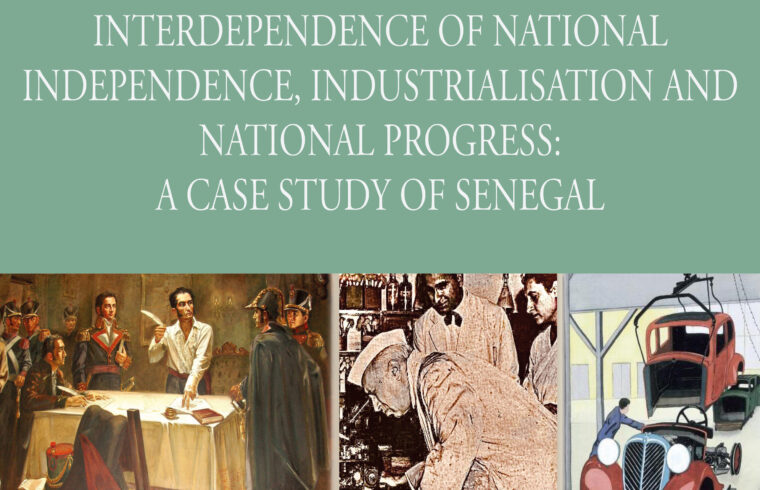Pape Mawade Sylla
Dr. in English Literature Cheikh Anta Diop University of Dakar, docsylla@outlook.com – SENEGAL
Introduction
The school, in its present form, is not the product of the internal development of African societies. In the case of Senegal, the creation and development of the school network followed the French penetration. Far from reducing the distance that separates the dominator from the dominated, the school has, in most cases, helped to make it impassable in order to maintain the colonial order. With the interdependency and national progress a new order is promoted to the young state, among other challenges, that of building, with an extroverted school, an identity and a sense of belonging to the senegalese nation based on the promotion of history, cultures and national languages. A system of education and training that is equitable, effective, and efficient, in line with the requirements of economic and social development and more committed to the care of children, and based on inclusive governance, increased accountability of local communities and valuable citizen. To grasp the meaning of this case study, an overview study of the Senegalese’s educational system should be done at first then we will shed light on the context for training development programs and educational progress.
I. Description of the education system
The Constitution of the Republic of Senegal stipulates that the State is responsible for the education policy defined and implemented by the Ministries in charge of Education and Training namely, the Ministry of Education, the Ministry Technical Education, Vocational Training, Literacy and National Languages and the Ministry of Family and Early Childhood. The state provides a public service mission at this level. To this end, the Orientation Law 91 22 of February 16, 1991 defines the orientations of the national education which tends to: – prepare the conditions of an integral development assumed by the whole nation – to promote the values in which the nation recognizes itself – raising the cultural level of the population The education system is structured in two sectors: the formal and the non-formal. Formal education concerns several levels and types of education. It is composed of pre-school education, elementary education, general and secondary general education, technical education and vocational training, and higher education. At each of these levels, there is, alongside public education, a private education that has diversified and developed in recent years. Inclusive education and girls‘ education occupy an increasingly important place in the system’s ambition to reduce the disparities created by disabilities of all kinds. Indeed, the care of children with specific educational needs and the massive enrolment of girls in school are now seen as strategies for providing a more equitable and democratic education service.
The non-formal education sector, under the responsibility of the Ministry of Technical Education, Vocational Training, Literacy and National Languages, includes literacy, basic community schools, schools of the 3rd type and Franco-Arab schools. The ambition displayed for the development of this sector is commensurate with the challenges of sustainable development, which must necessarily be based on the quality of available human resources. At the central level The Education and Training Sector is organized around 13 national directorates, 6 of which are dedicated to the different levels of education, in addition to the specialized services attached to the various ministerial cabinets. At the decentralized level At the level of the eleven (14) regions, one finds Inspections of Academy (16 IA) in charge of coordinating the educational action. At the departmental level, there are national departmental inspectorates of education (59 IDEN), responsible for the implementation of the education and training policy in their constituencies. In order to understand this educational progress setting out the context for development of education is necessary.
II. Context for development of education and training development programs
The educational policy of Senegal was inspired by the conclusions and recommendations of the international conferences (Jomtien 1990, Dakar 2000) and regional conferences (MINEDAF VI, 46th general session of the CONFEMEN, Panafrican Conference on the education of girls …). At the national level, the proposals of the National Commission for Reform of Education and Training (CNREF), formalizing the conclusions of the Estates General of Education and Training held in January 1981, are the basis of the law. Education Guideline No. 91-22 of 16 February 1991, which defines the profile of the new type of man to be promoted through education. The various sectoral consultations organized by the State since 1993 have been occasions for strongly reaffirming the aims and guiding principles of the educational system recommended by the Orientation Law. At each of these consultations, a non-complacent diagnosis of the state of the education system was made, and relevant recommendations were made to operationalize the CNREF’s proposals while adapting them to changes in the internal and external environment. The general policy options have recently been operationalized by the sector’s general policy letter and implemented through the Education and Training 10-year Program (Development), which has been developed over the years. years, by expanding the frame of reference. The Ten-Year Education and Training Program In the continuity of the Education Reform, the Government of Senegal has formulated a new „General Policy Letter of the Education / Training Sector“ for the period 2000-2017, which specifies the development policy options selected for the formal and non-formal subsectors, as well as the strategies for their implementation. . Education policy is now focused on strengthening the system, primarily on basic education, technical education and vocational training. In this context, the universalization of elementary school enrolment by 2010 is the overriding objective of the Government. Moreover, this educational policy is implemented through the Ten-Year Education and Training Program undertaken as part of the United Nations Special Initiative for Africa. This program defines the major axes around which the State of Senegal intends, with its technical, financial and social partners, to give a decisive impetus to the quantitative and qualitative development of the education system for the period 2000-2010. In addition, the State and its financial partners have agreed to commit, in the future, all the financial resources of the sector in the PDEF, which constitutes the instrument for implementing Senegal’s educational policy. The education system thus enters a phase of reform relative to the mode of management of the sector, by passing from a logic of project to a logic of program, of a subsector approach to a systemic approach which articulates the various sub-sectors. Education sectors by better managing student flows from one cycle to another. The reform of the Education and Training Development Program in the management of the education system has also been deepened because of decentralization. The transfer of skills in the planning and management of the education system to local authorities The decentralization process initiated in 1972 was consolidated in 1996 with the establishment of regions in local authorities with legal personality and financial autonomy to the local authorities. same as municipalities and rural communities. For this purpose, the State transferred to them nine areas of competence. With regard to education, the decision-making powers of local elected representatives have been strengthened: the region receives the general responsibility for planning the development of education at the local level. The municipality and the rural community receive skills in the management of educational services in basic education and the promotion of national languages. Through the development of the various planning instruments, such as the Regional Integrated Development Plans (PRDI), the Municipal Investment Plans (PIC) and the Local Development Plans (PLD), the local elected representatives now have the appropriate means. to consider endogenous perspectives of development by integrating educational concerns. Thus, in the framework of a partnership involving local authorities, decentralized school authorities, the private sector and civil society will be prepared, regional, departmental and local plans for the development of education, which will form an integral part of the partnership.
To develop and improve all aspects of early childhood care and education, including the most vulnerable and disadvantaged children; Ensure that by 2015 all children in difficulty and those belonging to ethnic minorities have the opportunity to access compulsory, free and quality primary education and to follow it to completion; To meet the educational needs of all young people and adults by ensuring equitable access to adequate programs aimed at acquiring knowledge and skills needed in everyday life; Improve by 50% the literacy level of adults, especially women, by 2015, and ensure that all adults have equitable access to basic education and lifelong education programs; Eliminate gender disparities in primary and secondary education by 2005 and achieve equality in this area in 2015, including ensuring girls have equitable and unrestricted access to quality basic education with the same chances of success; Improve in all its aspects the quality of education in the interest of excellence, so as to obtain recognized and quantifiable learning outcomes for all.
Conclusion
For education and training to be a real vector of development, they must be understood in their individual and collective dimensions. The human rights approach has been relevant in reflecting the multi-dimensionality of the right to education. For the Government of Senegal, the education system must better contribute to the provision of quality human resources, able to adapt to scientific and technological developments, capable of innovating. The state therefore has the ambition to create a school of equity and equal opportunities, a school that can carry its ambitions for emergence. Also, the new options, such as PACKET-EF 2013-2030, will focus on the correction of disparities further more, the professionalization of college-to-higher education, and the training of young people in demand-driven sectors. In this way „if access to school is a prerequisite for the acquisition of school knowledge, it is not a sufficient condition. Students must not only go to school, but acquire the knowledge that will help them stay and progress“ (Henaff& Lange, 2011). For a better educational progress, the authorities should put the emphasis on technological fields at early age and built strong profile of scientific students in order to reach national independence industrialization.
http://www.osiwa.org/wpcontent/uploads/2014/12/osiwa_ourstories.pdf
Henaff, N. & Lange M.-F. (2011). Inégalités scolaires dans le Sud: transformation et reproduction, 59, 3-18. Retrieved from http:// www.dri.gouv.sn/loi-12-février 2007-07
MEN / DAGE. (2009-2010). Rapport sur la performance du secteur de l’éducation et de la formation. Retrieved from https://ec.europa.eu/education/sites/education/files/document-library-docs/etmonitor-report-2018-france_fr.pdf
Michaelowa K. (2000). Dépenses d’éducation, qualité de l’éducation et pauvreté: l’exemple de cinq pays africainsfrancophones. Document technique n° 157 Centre de développement de l’OCDE, Paris.
Programme décennal de l’éducation et de formation. (2005). Perspectives documentaires en éducation N ° 62. Retrieved from http://ife.enslyon.fr/publications/editionelectronique/perspectives-documentaires/RP0
République du Sénégal J.O. (2007).[Loi n ° 2007/07]. Retrieved September 04, 2018, from http:// www.dri.gouv.sn/loi-12-février-2007-07.
République du Sénégal, J. O. (2013). [Loi n° 2013-10 du 28 décembre 2013 portant Code général des Collectivités[. Retrieved September 04, 2018, from https://www.ilo.org/dyn/natlex/docs/ELECTRONIC/97262/…/F…/SEN97262.pdf
République du Sénégal. (1977). [Loi n ° 77-67 du 4 juin 1977 portant loi de finances]. Retrieved September 07, 2018, from www.atddlgeoucad.org/documents/memoire_2011/fatoumata_signate.pdf
Seye Djité, S. (2019). Organization of the senegalese educational system. MLS Educational Research, 3(1), 79-92. Loi: 10.29314/mlser.v3i1.86
Soumaré, C.H., & Wade, A. (2008). [Decret n ° 2008-209 du 4 mars 2008] Retrieved September 04, 2018, from http://www.jo.gouv.sn/spip.php?article679
Unesco. (1971). [Loi d’orientation de l’éducation nationale N °5401N ° 5401, J.O. P107.N °71-36 du 03 juin.1971]. Retrieved September 04, 2018, from http://www.unesco.org/education/edurights/media/docs/7e634d754261abefab50 1f386836f84bb36fcaa4.pdf











